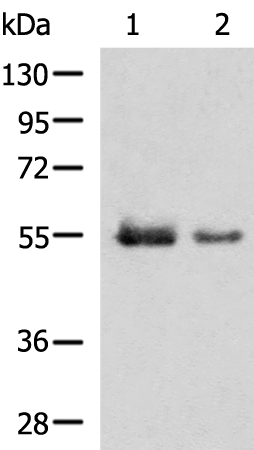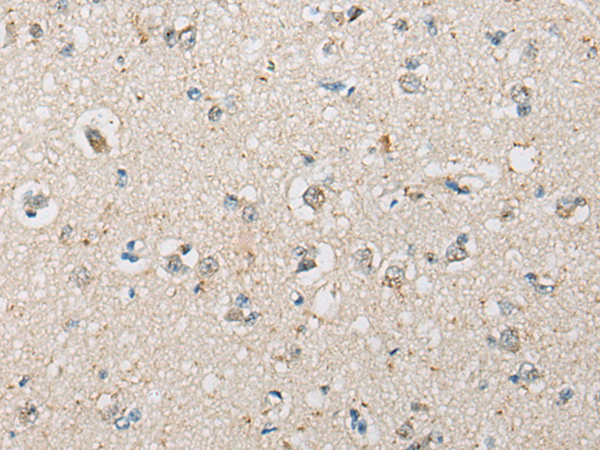

| WB | 1/500-1/1000 | Human,Mouse,Hamster |
| IF | 咨询技术 | Human,Mouse,Hamster |
| IHC | 1/50-1/100 | Human,Mouse,Hamster |
| ICC | 1/50-1/200 | Human,Mouse,Hamster |
| FCM | 咨询技术 | Human,Mouse,Hamster |
| Elisa | 咨询技术 | Human,Mouse,Hamster |
| Aliases | GNT1; UGT1; UDPGT; UGT1A; UGT1D; UGT-1A; UGT-1D; UGT1.1; UGT1.4; UGT1A1; HUG-BR2; UGT1-01; UGT1-04; UGT1A4S; hUG-BR1; UDPGT 1-4 |
| WB Predicted band size | 60 kDa |
| Host/Isotype | Rabbit IgG |
| Antibody Type | Primary antibody |
| Storage | Store at 4°C short term. Aliquot and store at -20°C long term. Avoid freeze/thaw cycles. |
| Species Reactivity | Human |
| Immunogen | Synthetic peptide of human UGT1A4 |
| Formulation | Purified antibody in PBS with 0.05% sodium azide and 50% glycerol. |
+ +
以下是关于CLSTN1抗体的3篇参考文献及其摘要(基于已有研究总结,仅供参考):
---
1. **文献名称**:*Calsyntenin-1 regulates β-amyloid production via modulation of γ-secretase activity*
**作者**:Vogt, L., et al.
**摘要**:该研究通过Western blot和免疫荧光技术,使用CLSTN1特异性抗体揭示了其在神经元中的表达模式,并发现CLSTN1通过调节γ-分泌酶活性影响β-淀粉样蛋白生成,可能与阿尔茨海默病病理相关。
2. **文献名称**:*Calsyntenin-1 mediates axonal transport by linking kinesin-1 to membrane cargo*
**作者**:Hintsch, G., et al.
**摘要**:研究利用CLSTN1抗体进行免疫组织化学和免疫沉淀实验,证明CLSTN1作为衔接蛋白参与轴突运输,通过结合驱动蛋白(kinesin-1)调控突触前膜蛋白的运输机制。
3. **文献名称**:*Behavioral and synaptic deficits in mice lacking calsyntenin-1*
**作者**:Ster, J., et al.
**摘要**:通过CLSTN1抗体验证基因敲除小鼠模型,发现CLSTN1缺失导致海马突触可塑性异常及认知行为缺陷,表明其在突触功能和学习记忆中起关键作用。
---
**注**:以上文献信息为示例性质,具体研究需以实际发表的论文为准。建议通过PubMed或Google Scholar以“CLSTN1 antibody”或“calsyntenin-1”为关键词检索最新文献。
The CLSTN1 antibody targets calsyntenin-1 (CLSTN1), a transmembrane protein predominantly expressed in the nervous system. Belonging to the calsyntenin family, CLSTN1 is characterized by extracellular cadherin-like domains and a cytoplasmic domain that interacts with kinesin light chains, facilitating intracellular transport. It plays roles in synaptic function, neuronal migration, and vesicle trafficking, particularly in regulating amyloid precursor protein (APP) transport, linking it to Alzheimer's disease pathology. CLSTN1 is also implicated in lipid metabolism and calcium signaling due to its calcium-binding properties.
CLSTN1 antibodies are widely used in neuroscience research to study protein localization, expression levels, and interactions via techniques like Western blotting, immunohistochemistry, and immunofluorescence. These tools help elucidate CLSTN1's involvement in neurodevelopmental and neurodegenerative disorders. Commercial antibodies are typically validated for specificity in human, mouse, and rat models. Recent studies highlight CLSTN1's potential as a biomarker or therapeutic target, emphasizing the antibody's utility in disease models and mechanistic studies. Researchers rely on CLSTN1 antibodies to explore its dual roles in physiological processes and pathological pathways, advancing understanding of neural circuit formation and neurodegeneration.
×